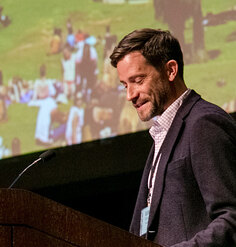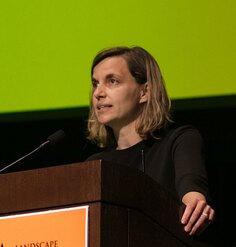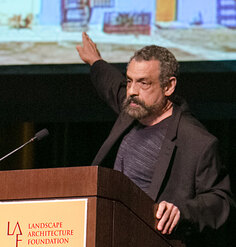Landscape Architecture as Necessity
By Kelly Shannon
This presentation was part of the Landscape Architecture Foundation’s The New Landscape Declaration: A Summit on Landscape Architecture and the Future held in Philadelphia on June 10-11, 2016. LAF asked a diverse group of leading minds to write a “Declaration” reflecting on the last half century and offering bold ideas for how landscape architecture can make its vital contribution in response to the challenges of our time.
Kelly Shannon
Professor, University of Southern California
Los Angeles, California
Kelly Shannon, Ph.D., is professor of architecture and director of the Graduate Program of Landscape Architecture and Urbanism at the University of Southern California. She earned her architecture degree at Carnegie Mellon University, a post-graduate degree at the Berlage Institute in Amsterdam, and a Ph.D. at the University of Leuven, where she focused on landscape to guide urbanization in Vietnam.
* Affiliation at the time of the Summit
Landscape Architecture as Necessity
by Kelly Shannon
The authors of the Landscape Architecture Foundation’s 1966 Declaration of Concern claimed they were brought together by a highly disturbing environmental crisis. They issued a call to arms for the profession of landscape architecture. Fifty years later, in a world that is increasingly divided, landscape architecture arguably remains the most powerful tool to marry social and ecological justice.
Landscape architecture has the capacity to address the most pressing and fundamental problems facing the world today: climate change, water and food security, afforestation, infrastructure, energy, and unchecked urbanization. An entirely new array of challenging programs and projects await the landscape architect. Moreover, in addition to designing for beauty and function, there is persuasive political agency of well-designed territories that work intelligently across scales and ecologies.
Landscape architecture involves systemic thinking, concerned with ecologies of dynamic change, with adaptability, resilience, and flexibility, while at the same time giving the necessary attention to the concrete and its materiality. Today we live in remarkably turbulent and critical times that require radical system change: politically, socioculturally, economically, and spatially. The status quo is unsustainable. For humanity. For planet Earth. For future generations of both.
We are now at a precipice, a critical tipping point, standing before the wholesale destruction of the planet. The never-ending, interlinked, and adaptive cycles of growth, accumulation, restructuring, and renewal occur in human and natural ecologies of nested sets of scales and timeframes. Landscape architecture must become the essential game changer in not only reshaping the earth’s ecological systems in practice but also in transforming the fundamental habitation of the planet through broader systemic thinking.
The world is marching toward catastrophe, and landscape architecture has a responsibility to be at the core of a categorical shift. Climate change is not pseudoscience. Compromised summit declarations do not have a forceful impact. Landscape architecture must set the boundaries for policy makers and orient social movements. Bold and inspired projects can lead policy.
The public context in the Global North requires careful yet bold reediting and recalibrating because the process of development transforms, optimizes, and corrects; the process is not primarily concerned with accommodating massive demographic, social, and economic growth in new urban areas. New hybrid ecologies must create innovative synergies between city and nature, between consumptive and productive space, between impermeable and porous surfaces, and between the urban and the rural.
In the Global South, where urbanization, industrialization, and migration gallop ahead, stabilizing natural ecologies must take place simultaneously with massive development. Robust green and blue systems can structure territories and create frames for adaptive landscapes. Resilience must be built into territories and cities by designing an overlap of natural and built ecologies.
Despite the impassioned plea of our colleagues 50 years ago, landscape architects have mostly been peripheral to large environmental agendas; in Western Europe, the field is at its most progressive with landscape architects occasionally leading major urban transformation projects and participating in robust infrastructure projects. The American landscape architect must more proactively create larger opportunities for the design of the environment beyond the piecemeal and ad hoc, and landscape architects must deepen their commitment and the political will for the continued expansion of the public realm. Clients must be cultivated, and the role of the landscape architect must be properly understood and valued at the national, regional, city, and local levels.
Immense opportunity and obligation await the American landscape architect in particular. Increasing civic discord across the nation’s cities and the effects of recent climate-related extremes like prolonged heat waves, droughts, floods, cyclones, and wildfires reveal the significant vulnerability and exposure of human and natural ecosystems. Taken together, this is a renewed wake-up call, and landscape architecture is urgently needed to create equitable and truly democratic public realms and to implement risk mitigation strategies.
At the same time, it is landscape architecture that has the ability, and, indeed the responsibility, to ground projects to their specificity: their workings, secrets, logic, opportunities, and inherent dangers. The “green wave” and corresponding performance-driven obsessions must not be a panacea. Fieldwork unveils specific geologies and geographies of contexts and the messiness and contested realities of the everyday; investigations into the existing logic of landscapes, cultural appropriations of a territory, social formation and codification of spaces require both diachronic and synchronic perspectives.
On-site interpretative mapping can go far beyond the descriptive and become a form of critical realism (critical in selecting what to map) and the base for insights through the discovery of unspoken and unwritten realities gained from a haptic and experienced sense. In turn, landscape architecture is the operative instrument for engaged resistance to relentless homogenization, globalization, and “flattening out” of cultures and places. Projects must be contextually embedded geographically, geologically, and culturally.
Landscape architecture is an ever more urgent necessity. It is simultaneously necessary for landscape architecture to reclaim its position as a key discipline—able to uniquely synthesize ecological systems, scientific data, engineering methods, social practices, and cultural values—and integrate them all into the design of the built environment. Bold visions must combine the tangible and the imaginary to provoke conversations that promote social equity and environmental justice as well as manifest landscape’s transformative power. It is time once again to make a strong call to arms to the profession to more actively engage with the world and prove that landscape architecture is a necessity. The political agency of the profession must be forcibly reactivated and the power of landscape architecture engaged to be the game changer in reshaping ecological systems and transforming forms of living.











